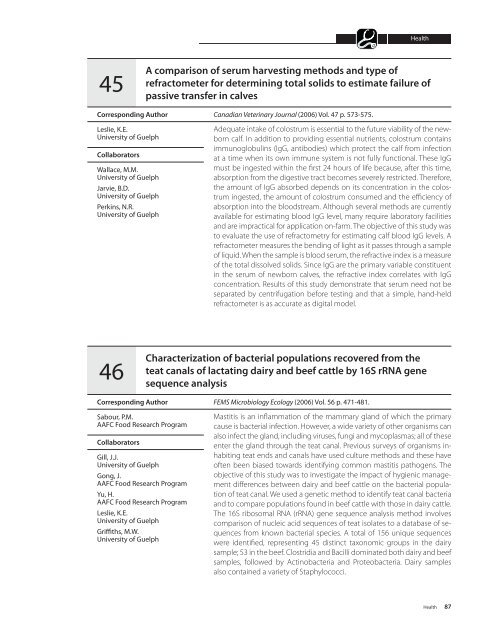A52-75-2007E.pdf - AgroMedia International Inc
A52-75-2007E.pdf - AgroMedia International Inc
A52-75-2007E.pdf - AgroMedia International Inc
Create successful ePaper yourself
Turn your PDF publications into a flip-book with our unique Google optimized e-Paper software.
Health45A comparison of serum harvesting methods and type ofrefractometer for determining total solids to estimate failure ofpassive transfer in calvesCorresponding AuthorLeslie, K.E.University of GuelphCollaboratorsWallace, M.M.University of GuelphJarvie, B.D.University of GuelphPerkins, N.R.University of GuelphCanadian Veterinary Journal (2006) Vol. 47 p. 573-5<strong>75</strong>.Adequate intake of colostrum is essential to the future viability of the newborncalf. In addition to providing essential nutrients, colostrum containsimmunoglobulins (IgG, antibodies) which protect the calf from infectionat a time when its own immune system is not fully functional. These IgGmust be ingested within the first 24 hours of life because, after this time,absorption from the digestive tract becomes severely restricted. Therefore,the amount of IgG absorbed depends on its concentration in the colostrumingested, the amount of colostrum consumed and the efficiency ofabsorption into the bloodstream. Although several methods are currentlyavailable for estimating blood IgG level, many require laboratory facilitiesand are impractical for application on-farm. The objective of this study wasto evaluate the use of refractometry for estimating calf blood IgG levels. Arefractometer measures the bending of light as it passes through a sampleof liquid. When the sample is blood serum, the refractive index is a measureof the total dissolved solids. Since IgG are the primary variable constituentin the serum of newborn calves, the refractive index correlates with IgGconcentration. Results of this study demonstrate that serum need not beseparated by centrifugation before testing and that a simple, hand-heldrefractometer is as accurate as digital model.46Characterization of bacterial populations recovered from theteat canals of lactating dairy and beef cattle by 16S rRNA genesequence analysisCorresponding AuthorSabour, P.M.AAFC Food Research ProgramCollaboratorsGill, J.J.University of GuelphGong, J.AAFC Food Research ProgramYu, H.AAFC Food Research ProgramLeslie, K.E.University of GuelphGriffiths, M.W.University of GuelphFEMS Microbiology Ecology (2006) Vol. 56 p. 471-481.Mastitis is an inflammation of the mammary gland of which the primarycause is bacterial infection. However, a wide variety of other organisms canalso infect the gland, including viruses, fungi and mycoplasmas; all of theseenter the gland through the teat canal. Previous surveys of organisms inhabitingteat ends and canals have used culture methods and these haveoften been biased towards identifying common mastitis pathogens. Theobjective of this study was to investigate the impact of hygienic managementdifferences between dairy and beef cattle on the bacterial populationof teat canal. We used a genetic method to identify teat canal bacteriaand to compare populations found in beef cattle with those in dairy cattle.The 16S ribosomal RNA (rRNA) gene sequence analysis method involvescomparison of nucleic acid sequences of teat isolates to a database of sequencesfrom known bacterial species. A total of 156 unique sequenceswere identified, representing 45 distinct taxonomic groups in the dairysample; 53 in the beef. Clostridia and Bacilli dominated both dairy and beefsamples, followed by Actinobacteria and Proteobacteria. Dairy samplesalso contained a variety of Staphylococci.Health 87





